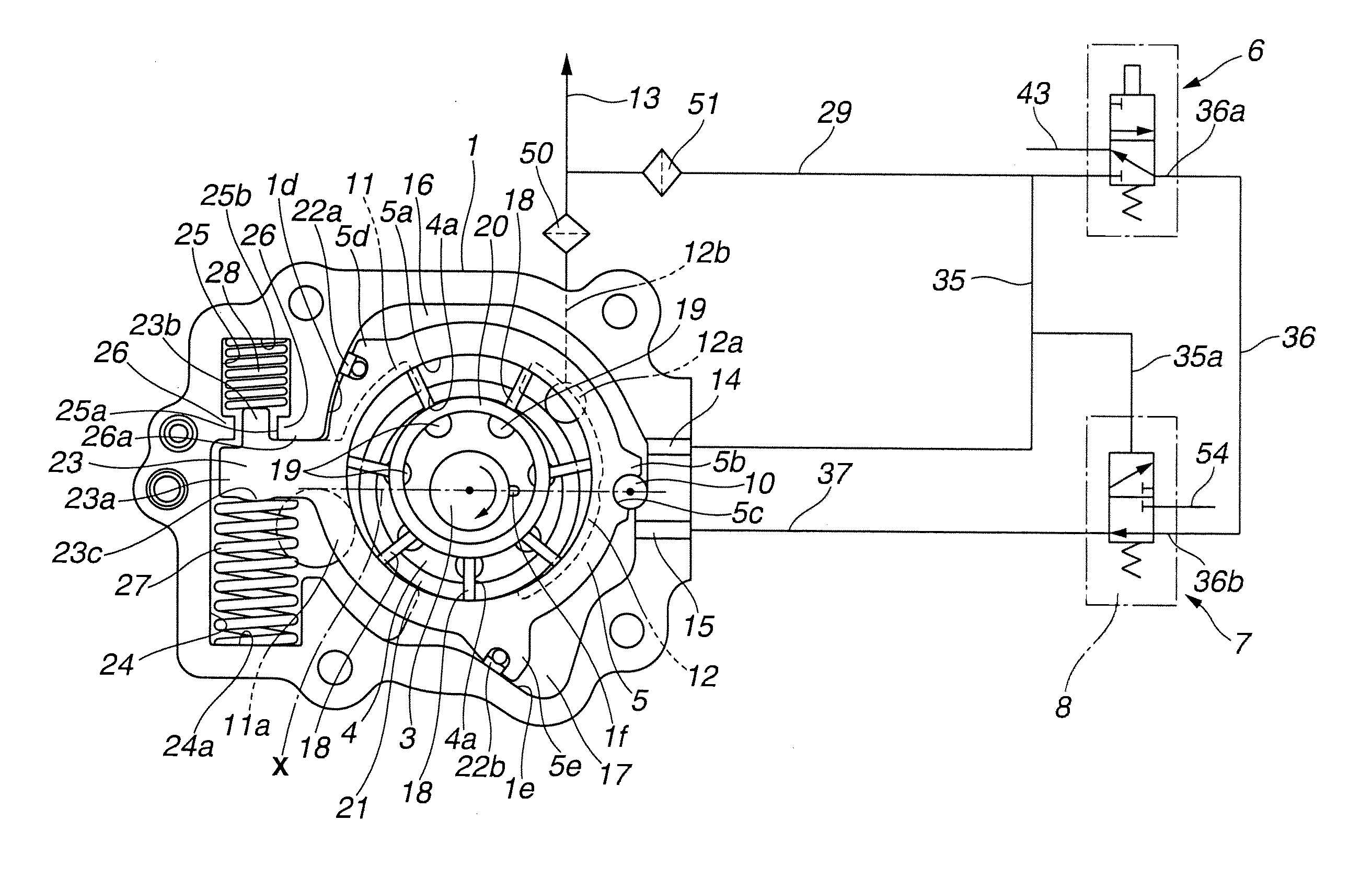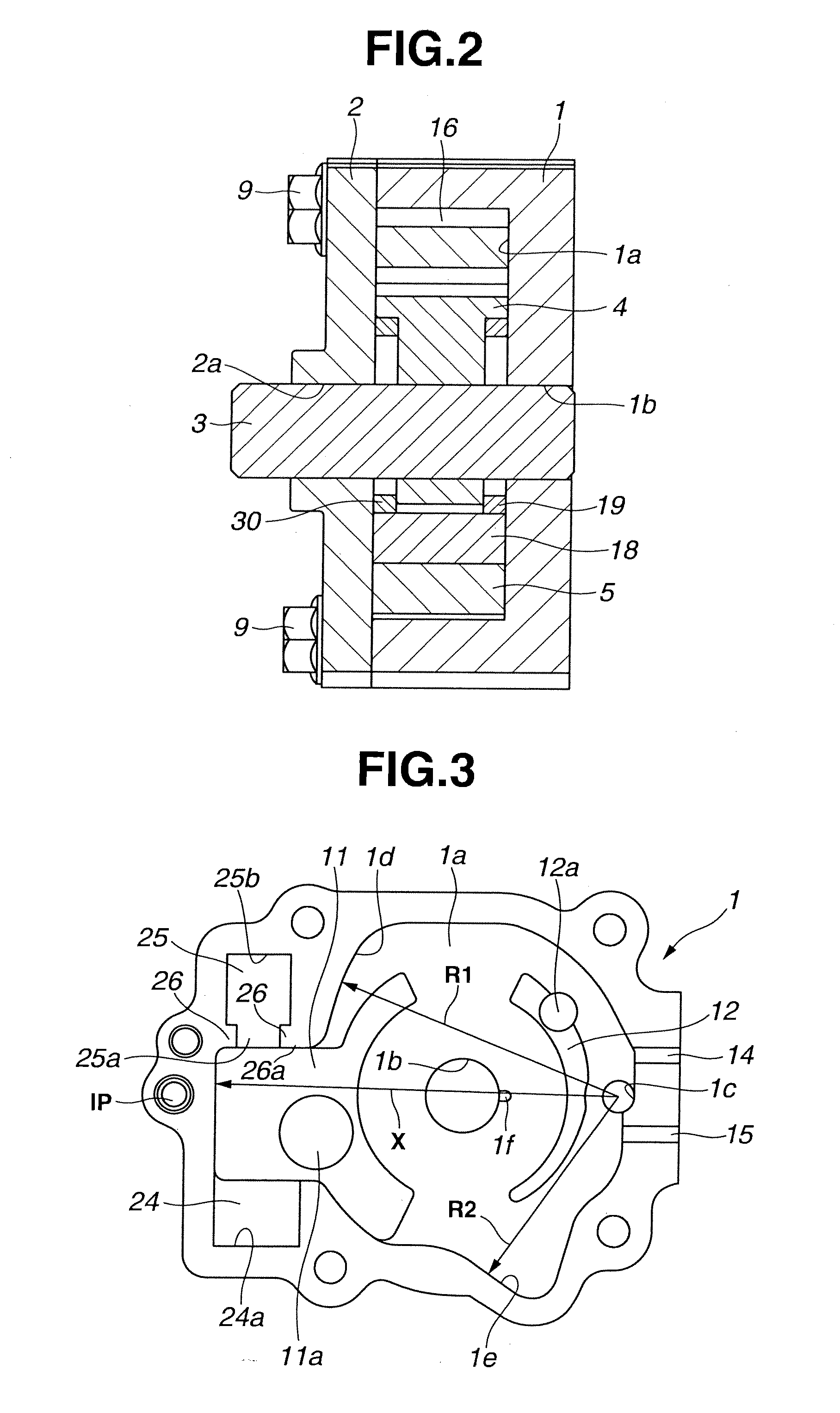Variable displacement pump
a variable-discharge pump and pump body technology, applied in the direction of liquid fuel engines, machines/engines, rotary piston liquid engines, etc., can solve the problems of unfavorable or difficult to achieve the oil pressure required for the piston cooling oil jet, waste of oil quantity and driving power, etc., to achieve the effect of improving reliability and reducing energy consumption
- Summary
- Abstract
- Description
- Claims
- Application Information
AI Technical Summary
Benefits of technology
Problems solved by technology
Method used
Image
Examples
first embodiment
Operation of First Embodiment
[0089]In the state shown in FIG. 1, by the resulting force of the spring forces of first coil spring 27 and second coil spring 28, the upper surface of arm 23 of cam ring 5 abuts against stopper surface 26a in a lower end of one retaining portion 26. In this state, the eccentricity is greatest, and the volume change of each pumping chamber 21 with rotation is greatest. Therefore, the discharge volume or capacity of the oil pump is greatest.
[0090]The rotor 4 of the pump main body is rotated in the clockwise direction as shown by an arrow in FIG. 1, by the drive shaft 3, and hence the pump chambers 21 expand in the state opening to the intake port 11 in a left side region on the left side in FIG. 1. Intake port 11 is allowed to suck the oil from the oil pan outside the pump through the intake hole or opening 11a. In a right side region in FIG. 1, the pump chambers 21 shrink in the state opening to the drain port 12, so that the oil is discharged to dischar...
second embodiment
[0114]FIG. 11 shows a variable displacement pump according to a second embodiment. The pilot valve 7 is connected with a downstream end of a branch passage 36c branching off from the connection passage 36. The downstream end of branch passage 36c is connected to the upper portion bounded by the pressure receiving surface 52e of first land 52a of spool 52. Thus, the spool 52 receives the discharge pressure on the downstream side of thermosensitive valve 6. With this arrangement, the variable displacement pump according to the second embodiment can provide operations and effects similar to those of the first embodiment.
third embodiment
[0115]FIGS. 12˜14 show a variable displacement pump according to a third embodiment. In the third embodiment, unlike the first embodiment, the pilot valve 7 is configured to have a drain function of second control chamber 17 in the initial state, instead of thermosensitive valve 6.
[0116]Specifically, in thermosensitive valve 6, as shown in FIGS. 13A and 13B, the drain port (43) is eliminated, and the cylinder bore 31 is formed with three openings: the open end 29a of branch passage 29, the open end 36a of connection passage 36, and the open end 35a of first communication passage 35. Moreover, the annular groove (32e) is not formed in the outside circumferential surface of valve member 32.
[0117]In the pilot valve 7, as shown in FIGS. 14A-14C, the open end of branch passage 36c of connection passage 36 is opened into the upper portion bounded by the pressure receiving surface 52e of first land 52a of spool 52; and an open end 56a of a second drain port 56 is opened to a slide bore 50 ...
PUM
 Login to View More
Login to View More Abstract
Description
Claims
Application Information
 Login to View More
Login to View More - R&D
- Intellectual Property
- Life Sciences
- Materials
- Tech Scout
- Unparalleled Data Quality
- Higher Quality Content
- 60% Fewer Hallucinations
Browse by: Latest US Patents, China's latest patents, Technical Efficacy Thesaurus, Application Domain, Technology Topic, Popular Technical Reports.
© 2025 PatSnap. All rights reserved.Legal|Privacy policy|Modern Slavery Act Transparency Statement|Sitemap|About US| Contact US: help@patsnap.com



